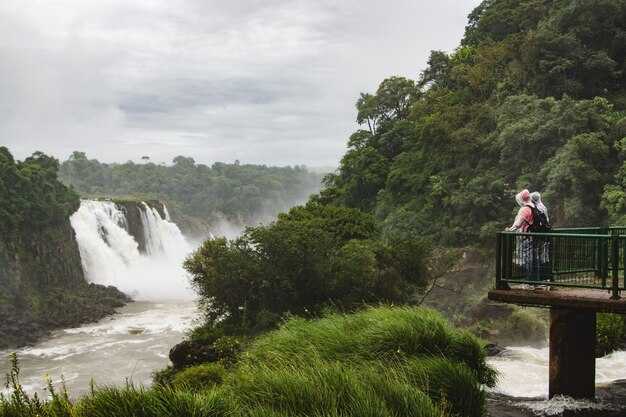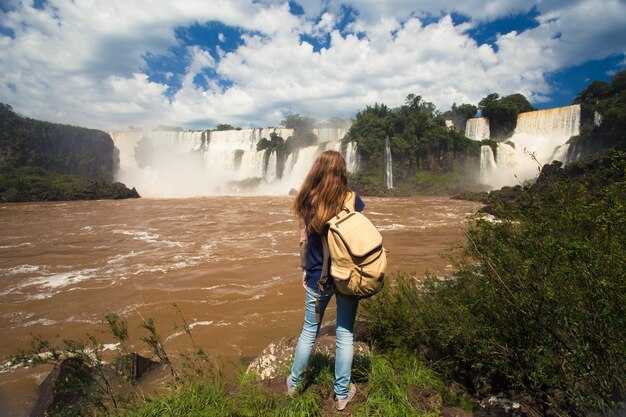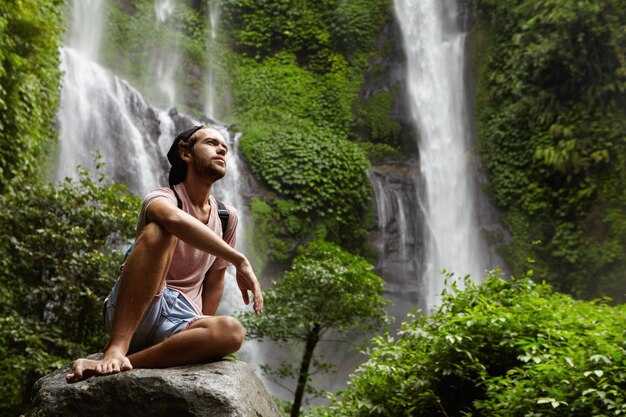advice: arrive before 9 am to enjoy cooler temperatures and clearer viewpoints on the Brazilian side. If you have arrived, head straight to the upper decks to catch the spray without long lines. Plan your route to maximize short walks between shaded spots and bring a light backpack with sunscreen and a microfiber towel.
Find your base: The belmond Hotel das Cataratas on the Brazilian side offers easy access to the park entry. If you lean toward budget options, frequent hostels around Foz do Iguaçu keep daily costs reasonable. michaela, an australian traveler, says a flexible plan and conversation with staff unlock quiet paths after rain. bring an amount for local taxis or shuttle buses, and reserve a couple of hours for a relaxed morning walk.
What to wear and pack: Wear sturdy shoes with grip for slippery stones. dont forget a lightweight rain jacket; the spray from the falls sticks to everything. Pack a compact poncho, bottled water, and a small power bank for photos. A daily plan helps you hit viewpoints in the best light, especially as temperatures rise.
Plan your route: Start at the main Brazilian circuit and work your way to the Garganta do Diabo overlook. Use the park shuttle to hop between trailheads, especially in peak heat. Look for wildlife, like toucans and coatis, along shaded stretches. A well-timed visit in the morning or late afternoon yields better lighting for photos.
Practical tips: Bring protection for cameras; the spray can fog lenses. dont rely on data connectivity in the park; download offline maps beforehand. The amount of walking is moderate but stairs add up; take breaks and hydrate. Consider a late-afternoon viewpoint, when temperatures drop again and mist creates rainbows.
Best Time to Visit the Brazilian Side for Garganta do Diabo Viewpoints
Plan your visit for May or September and start before 9 a.m. to catch Garganta do Diabo viewpoints on the Brazilian side with soft light and thinner crowds.
In these dry-season months, the wide catwalk stays dry, the air is comfortable, and visibility is best for photography. If you come in summer, be ready for higher humidity and occasional showers that heighten the mist and create dramatic portraits; the views remain powerful, especially in early morning light or late afternoon when the land and forest contrast most.
weve found that morning visits pay off: over the years, travelers have learned to optimize timing by starting early; weekdays are generally calmer; backpackers and local guests mix with day-trippers on weekends, but the quieter hours are still present. To simplify logistics, use rideshare from town to the park entrance, a reliable means to avoid parking hassles. On-site facilities provide a simple lunch option at the gate, but for a fuller meal you can purchase in town or at a nearby mall after your visit. wifi coverage is strongest near the main plaza; along the main catwalks it can be spotty, so download offline maps in advance. At the gate you obtain a map and can purchase tickets online to start smoothly. The Garganta route on the Brazilian side is wide and well-maintained, with viewpoints that place you between the spray and the forest land; some overlook on the opposite bank offer a different perspective if you plan a separate day trip to the Argentine side.
Timing and viewpoints
- Start early: aim for 7:00–9:00 a.m. to beat crowds and catch the best light.
- Prefer May or September for lower rainfall and comfortable temperatures, with strong water flow still present.
- Choose weekdays when possible; weekends draw backpackers and families, increasing crowding at key lookouts.
- Check the weather and park alerts the night before; morning mists can affect visibility if you start too late.
Practical planning

- Wear sturdy shoes for a wide, well-maintained path that remains mostly flat but can be slick after rain; plan for tiny spray droplets on skin and glasses.
- Pack light rain gear, sunscreen, and a small backpack; dorm-style hostels around town offer budget options if you’re traveling with a group.
- Purchase tickets online in advance to start your day smoothly; at the gate you can obtain a map and you’ll see coverage updates on-site.
- Use rideshare means to reach the entrance; it’s a common, cost-effective option for solo travelers and groups.
- Be mindful of wifi coverage: stay offline with maps if the signal is weak on the trails; download the route beforehand.
- Consider adding a second day to explore the Argentine side for a fuller variety of viewpoints between the two countries.
Getting There: From Foz do Iguaçu to the Brazilian Park Entrance
Book a private transfer or use a reliable taxi to reach the Brazilian Park Entrance quickly. From Foz do Iguaçu to the entrance, expect about 25–30 km of road, 30–45 minutes in light traffic; peak times can stretch it to 60 minutes. If you arrive via the IGU airport or other area airports, a pre-booked shuttle or taxi offers door-to-gate service, saving you stops and backtracking. Here’s a practical approach that keeps everyone on track.
Two solid ride options: private transfer or public bus
Option A: Private transfer. A driver waits in the arrivals hall at IGU or at your hotel and delivers you directly to the Park Entrance. Expect to pay around R$80–120 one way, depending on your hotel location and traffic; it’s better to pay a bit more for reliability, especially with kids or a lot of gear. If you’re traveling with others, the per-person cost drops and the space helps you pack everything you need. Passengers appreciate the convenience after travel, and the driver can stop for a quick photo along the road if you ask.
Option B: City bus. From downtown Foz, Bus 120 Cataratas runs roughly every 30–40 minutes and stops at the park gate. The ride takes about 60–75 minutes and costs around R$5–7. Board at the Terminal de Ônibus or at major urban stops; you’ll avoid parking hassles but share the ride with other passengers. If you missed the first bus, there are later departures–check the current timetable at your hotel or the terminal; plan to arrive early to beat the heat and crowds. Instead, if you’re on a tight budget, this is a better choice for the day.
There, crossing to the argentinean side is optional but can be a good complement in a full day. If you decide to cross, bring your passport and be prepared for customs checks; plan a separate entry and exit window, and note that afternoon temperatures can rise a few Fahrenheit degrees. If you want to explore ciudad neighborhoods on the other side, do it after you finish here and return for the Brazilian gates.
Practical packing and planning: pack light, leave bulky bags at the hotel if possible, and carry a small water bottle; the weather on the Brazilian side is sunny most days. In summer, temperatures often peak in the 80s or 90s Fahrenheit, so sunscreen, a hat, and a light jacket for cooler mornings help. The entry plaza is a short walk from the bus stop, but you’ll do more walking inside the park beyond the gate. Here, the shortest walk from the gate to the main outlooks takes about 15–25 minutes. If you’re touring with kids, pace yourself and add rests; everyone benefits from a relaxed rhythm. Create a simple itinerary list to guide your day, then review it at the bus stop to learn about current conditions and time windows, and leave some buffer for unexpected stops with others who share tips and plans.
Finally, a quick note to add to your plan: begin at the entrance, buy tickets, and consider the electric train for faster access to the most famous viewpoints on the Brazilian side. The vistas are amazing, and mornings offer softer light for photos. If you want a special day that blends park scenery with city culture, this route is worth the effort. The plan is straightforward, practical, and designed for smooth travel; by following these steps, you’ll avoid delays and enjoy the falls with less stress.
Ticketing, Parking, and Entrance Logistics for Garganta do Diabo
Purchase tickets online in advance and select an earlier time slot to make the visit easier and to avoid crowded queues during peak months.
Ticketing options on the official site include single-entry passes and combination experiences. Price varies by age and country of residence, with exchange rates available at checkout. The site accepts cards and cash, and the counter at the entrance can process exchanges for nearby networks if necessary.
Parking near the entrance is limited. Lot A sits closest to the Brazil-side entry, while Lot B is about a kilometre away along a walkable path. Expect hourly rates, with payment possible at the booth or via a mobile app. Plan for 1–2 hours if you want to explore both circuits and the lookout points without rushing.
Entrance logistics place you at a controlled gateway for Garganta do Diabo. Gates open early and close in the late afternoon; bring only essential belongings to speed checks, as staff conduct standard security inspections. Have your requirements ready–photo IDs, tickets, and any permitted tech–while keeping belongings compact to avoid intrusive lines. Use the main walkway and circuit route to reach the famous lookout without backtracking.
Local guidance from avid visitors adds value: Silva, a guide from Barroso, suggests starting at the lower circuit lookout to catch the best light, then following the walkways along the main circuit. The route is walkable for most guests, with a comfortable kilometre-scale stretch between lookouts. After the falls, many travelers enjoy a relaxed dinner nearby before departing for the airports or hotels in the country.
| Kategorie | Doporučení | Poznámky |
| Ticketing | Book online; choose morning slot; print or save on phone | Price varies by country and age; exchange available at counter |
| Parking | Use Lot A near entry; Lot B is a short kilometre walk | Pay hourly; app or gate; plan 1–2 hours |
| Entrance | Arrive early; carry only essentials | Security checks are standard; lookouts along the walkway |
| Tipy | Bring water, wear walkable shoes, consider a dinner stop after | Avid photographers will appreciate early light; Silva recommends route via lower circuit |
The Main Trail: Distances, Prime Viewpoints, and Walking Time to Devil’s Throat
Start at the entrance and walk directly toward Garganta do Diabo; this one-way segment conveniently sets you up for the final platform and definitely feels efficient for most visitors.
Hlavní stezka k Ďáblovu chřtánu má zhruba 2 km jedním směrem a pohodlné venkovní tempo umožňuje dojít přibližně za 40–50 minut chůze. Pokud se plánujete zdržet na každé vyhlídce a pořídit spoustu fotografií, počítejte s 60–90 minutami na celý přístup k finální plošině.
Zásadní hlediska a rozsah chůze
Po zhruba 0,7–0,9 km se z prvního vyhlídkového místa naskýtá široký výhled na dolní kaskády a mlhu, která za jasného světla vytváří duhy. Pokračováním dalších 0,5–0,6 km se dostanete na platformu uprostřed stezky s širším panoramatem přes řeku a zalesněné břehy.
Konečná platforma Garganta do Diabo se nachází zhruba na 2 km, a nabízí tak nejvyšší a nejúžasnější pohled zblízka na kaskádu ve tvaru podkovy. Je to ten vysoký, dramatický moment, který každý fotografuje, s mlhou ve větru a dramatickým měřítkem, díky kterému se zbytek trasy zdá stát za to.
Po cestě najdete sedadla a zastíněná místa k odpočinku, díky čemuž je procházka pohodlnější pro rodiny i pro každého, kdo dbá na teplo nebo slunce. V případě potřeby mobility se v návštěvnickém centru informujte o přístupu na horní terasy s pomocí výtahu; některé úseky nabízejí bezbariérový přístup nebo alternativní trasy na hlavní palubu.
Ať už přijdete ráno nebo odpoledne, stín a posezení vám pomůžou udržet stálé tempo. Z vyhlídek uvidíte řeku široce se rozprostírající na severozápad a okolní džungli, kde je během klidnějších hodin možné spatřit divokou zvěř. Hledejte značky ve španělštině a portugalštině, které označují vzdálenosti, a mějte mapy po ruce pro podrobný plán vašich konkrétních zastávek. Pokud se cítíte plní energie, každá vyhlídka se stane outdoorovou aktivitou, která promění samotnou cestu v kompaktní výlet.
Tento plán si můžete přizpůsobit svému tempu a zájmům. Pokud se zdržujete v okolí, nedaleké restaurace nabízejí rychlé občerstvení před nebo po procházce; pokud spěcháte, můžete trasu zkrátit tím, že se otočíte po první nebo druhé vyhlídce a stále zachytíte hlavní zajímavosti.
Co si obléct a co si sbalit na procházky deštným pralesem
Začněte s rychleschnoucími kalhotami nebo kraťasy a prodyšnou, nepromokavou bundou; obujte si pevnou obuv s uzavřenou špičkou a dobrou přilnavostí. Pokud plánujete přesun na kole nebo krátkou jízdu mezi místy, zvolte obuv, která dobře sedí, a vezměte si rukavice.
Vrstvení pomáhá: základní vrstva odvádějící vlhkost, lehká střední vrstva a kompaktní nepromokavá bunda. To, co si obléknete, závisí na předpovědi a vaší toleranci vlhkosti; rána jsou chladnější a ve vyšších nadmořských výškách se mohou rychle oteplit. Déšť může přijít velmi rychle, takže buďte připraveni.
Co si zabalit
Od vchodu si vezměte denní batoh o objemu 8–12 litrů se suchým vakem na elektroniku. Zabalte si láhev s pitím nebo hydratační systém; zaměřte se alespoň na 1,5 litru na 60–90 minut chůze.
Ochrana proti slunci: klobouk, sluneční brýle, opalovací krém. Ochrana proti hmyzu: repelent. Ochrana proti dešti: pončo nebo lehká nepromokavá bunda, pokud váš batoh nemá obal.
Vodotěsné pouzdro na telefon nebo fotoaparát; náhradní baterie; energetická tyčinka.
Termální prameny jsou poblíž, takže si vezměte ručník, pokud se plánuje návštěva termálních pramenů po procházce.
Mějte u sebe hotovost v pesos pro hraniční oblasti; většina nákupů uvnitř parku akceptuje karty, ale některé stánky spoléhají na hotovost. Pro ubytování a stravu jsou poblíž hotely a restaurace; plánujte podle toho.
Národní i mezinárodní návštěvníci si mohou zajistit transfery a taxi před vchodem; otevírací doba se liší podle sezóny. Většina okruhů trvá 60–90 minut; v některých dnech je provoz silnější, proto si naplánujte několik minut navíc na fotografování a vyhlídky.
Tipy pro fotografování: Zachycení vodopádů Iguazu z brazilské strany
Vydejte se do oblasti Porta za svítání, kde na vás čeká svěží tříšť a teplé světlo na skokanské platformě; mějte připravený rychlý objektiv a často otírejte vlhkost z filtru, abyste udrželi ostré hrany mlhy. Osvojte si střelecké návyky: kontrolujte světlo každých několik minut a projděte scénu, než se rozhodnete, abyste nepropásli prchavou duhu.
Na brazilské straně jsou stezky omezené v úhlech pohledu, takže si naplánujte okruh na 60–90 minut, abyste obsáhli hlavní vyhlídky a vnitřní cesty korunami stromů. Zkontrolujte aktualizované otevírací hodiny parku a odjezdy, abyste svůj harmonogram sladili s klidnějšími momenty; datum a počasí ovlivňují odrazy a celkové podmínky se mohou rychle změnit. Pokud kombinujete výlety do misí, pečlivě koordinujte, ale zůstaňte flexibilní, abyste se vyhnuli rušivým davům. Použijte to jako základ pro plánování trasy, abyste maximalizovali sluneční světlo na každém výhledu.
Uvnitř parku mohou být davy lidí v blízkosti hlavních platforem rušivé; snažte se fotografovat těsně po výbuchu spreje, pak vkročte do svěžích okrajů pro intimní záběry blízko vody. Buďte opatrní na divokou zvěř podél okrajů, včetně koček. Parkování je pohodlné poblíž vchodu, ale vraťte se zpět před vrcholem náporu kyvadlové dopravy; najdete překvapivě klidná místa podél vedlejších stezek a budete rádi, že jste měli pohodlnou obuv na ochranu nohou.
Nejlepší časy a vyhlídkové body
Nejlepší světlo nastává po úsvitu; z pohledu Salto zachytíte duhu, jak slunce stoupá. Z některých vyhlídek uvidíte ohromné výhledy na vodní oponu, poté se posunete po promenádě a orámujete vodopády, jak se sprej vine lesem. Pro mimořádně dramatické siluety se zdržte do pozdního rána a znovu pozdního odpoledne, kdy se stíny táhnou podél kaskády. Zvažte druhé kolo na vnitřní smyčce, abyste zachytili vodní stuhy skrz stromy. Celkově si vyberte několik klíčových míst a použijte lehký stativ, abyste se vyhnuli kolísání na promenádě, a přitom vždy ponechte prostor pro sledování měnícího se spreje.
Vybavení, nastavení a plánování

Používejte širokoúhlý objektiv (16–35 mm) pro panoramata a střední teleobjektiv (70–200 mm) pro detaily vodních ploch a mlhavých aur. Nastavte expozici kolem f/8–f/11 a ISO 100–200; pro hedvábnou vodu zkuste 1–2 sekundy se stabilním stativem, nebo přepněte na kratší časy závěrky, pokud vítr mění směr ostřiku. Polarizační filtr pomáhá omezit odlesky v jasných dnech a filtr s neutrální hustotou prodlužuje dlouhé expozice. Fotografujte do formátu RAW a používejte aplikace k mapování tras, kontrole parkování a sledování časových oken a odjezdů. Pokud se ubytujete poblíž, 2–3 hodinové okno vyhovuje pohodovému tempu; pro výlety s rodinou udržujte krátké úseky a umožněte si luxusní pobyt v okolí. Pokud zkombinujete cestování za misiemi nebo zkombinujete výlety, najdete více scenérií a méně čekání. Na závěr si rychle zkontrolujte nohy: ustupte zpět, abyste zhodnotili měřítko a ochránili své vybavení před ostřikem.



Komentáře